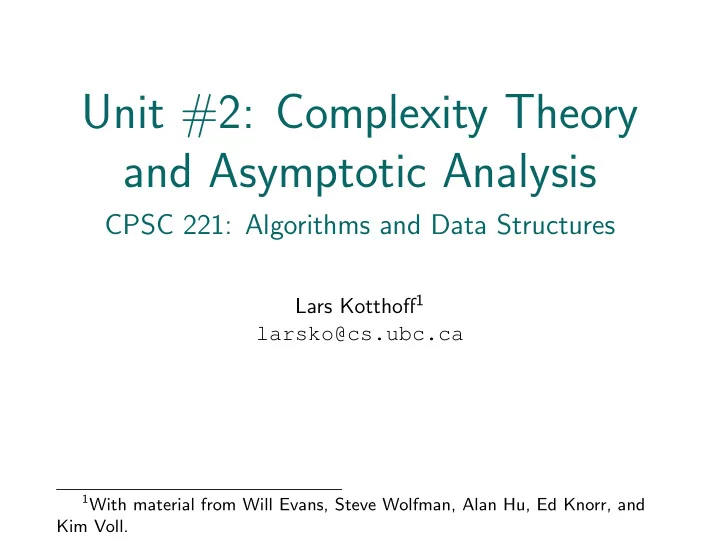

Unit #2: Complexity Theory and Asymptotic Analysis CPSC 221: Algorithms and Data Structures Lars Kotthoff 1 larsko@cs.ubc.ca 1 With material from Will Evans, Steve Wolfman, Alan Hu, Ed Knorr, and Kim Voll.
Types of analysis if random() == 0 return if random() == 1 for i = 1 to n do for j = 1 to n do k = 1 return else for i = 1 to n do k = 1 return
Types of analysis if random() == 0 Best case: T ( n ) = 1 return if random() == 1 for i = 1 to n do for j = 1 to n do k = 1 return else for i = 1 to n do k = 1 return
Types of analysis if random() == 0 Best case: T ( n ) = 1 return if random() == 1 for i = 1 to n do Worst case: T ( n ) = n 2 for j = 1 to n do k = 1 return else for i = 1 to n do k = 1 return
Types of analysis if random() == 0 Best case: T ( n ) = 1 return if random() == 1 for i = 1 to n do Worst case: T ( n ) = n 2 for j = 1 to n do k = 1 return else for i = 1 to n do Average case: T ( n ) = n k = 1 return
. . . . . . Types of analysis Best case: T ( n ) = 1 Worst case: T ( n ) = n 2 Average case: T ( n ) = n
. . . . Types of analysis T ( n ) O Best case: T ( n ) = 1 Θ Ω . . . . . . . n n 0 Worst case: T ( n ) = n 2 Average case: T ( n ) = n
. . Types of analysis T ( n ) O Best case: T ( n ) = 1 Θ Ω . . . . . . . n n 0 T ( n ) O Θ Ω Worst case: T ( n ) = n 2 . . . . . . . n n 0 Average case: T ( n ) = n
Types of analysis T ( n ) O Best case: T ( n ) = 1 Θ Ω . . . . . . . n n 0 T ( n ) O Θ Ω Worst case: T ( n ) = n 2 . . . . . . . n n 0 T ( n ) O Θ Average case: T ( n ) = n Ω . . . . . . . n n 0
“Tight” bounds ▷ informally: want to have “good” bounds ▷ no better reasonable bound which is asymptotically different ▷ rigid definition: Θ
Runtime example #3 i = 1 while i < n do for j = 1 to i do sum = sum + 1 i += i
Runtime example #4 int max(A, n) if (n == 1) return A[0] return larger of A[n-1] and max(A, n-1) Recursion almost always yields a recurrence relation: T (1) ≤ b T ( n ) ≤ c + T ( n − 1) if n > 1 Solving recurrence: T ( n ) ≤ c + c + T ( n − 2) (substitution) ≤ c + c + c + T ( n − 3) (substitution) ≤ kc + T ( n − k ) (extrapolating k > 0 ) = ( n − 1) c + T (1) (for k = n − 1 ) ≤ ( n − 1) c + b T ( n ) ∈
Runtime example #5: Mergesort Mergesort algorithm: Split list in half, sort first half, sort second half, merge together Recurrence relation: T (1) ≤ b T ( n ) ≤ 2 T ( n/ 2) + cn if n > 1 Solving recurrence: T ( n ) ≤ 2 T ( n/ 2) + cn ≤ 2(2 T ( n/ 4) + cn/ 2) + cn (substitution) = 4 T ( n/ 4) + 2 cn ≤ 4(2 T ( n/ 8) + cn/ 4) + 2 cn (substitution) = 8 T ( n/ 8) + 3 cn ≤ 2 k T ( n/ 2 k ) + kcn (extrapolating k > 0 ) (for 2 k = n ) = nT (1) + cn lg n T ( n ) ∈
Recommend
More recommend